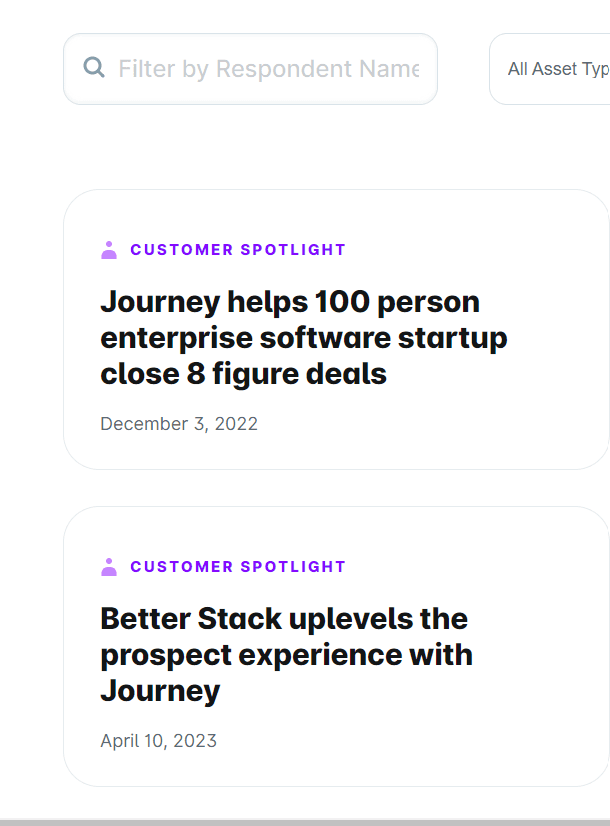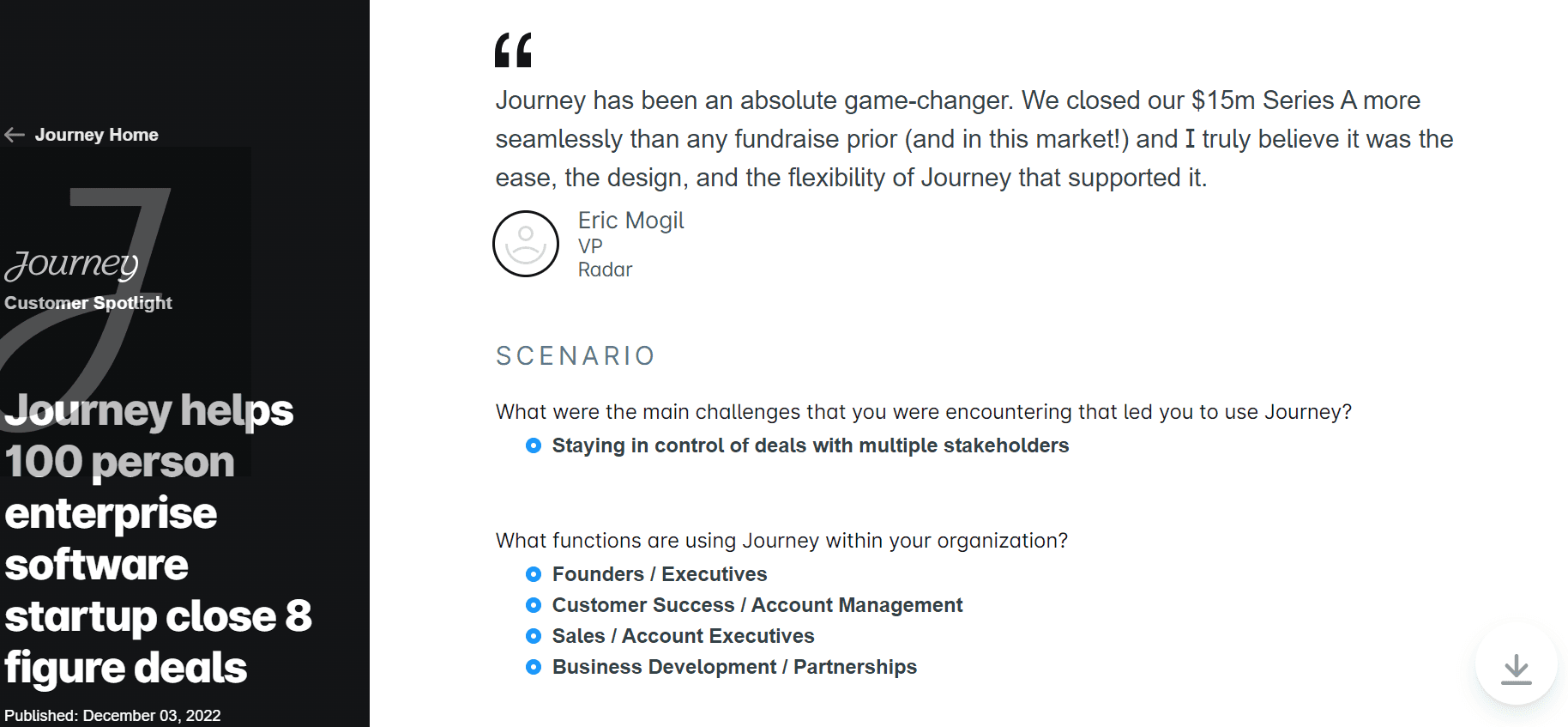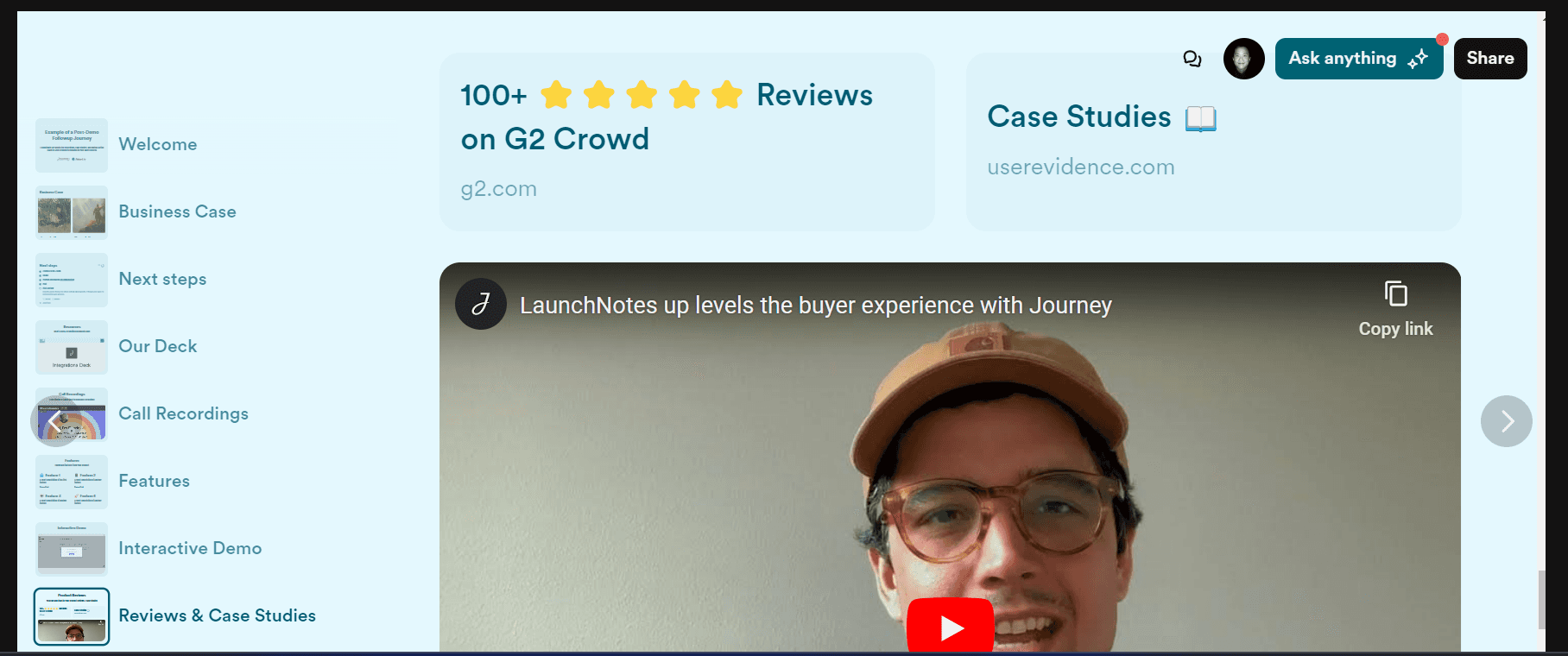March 1, 2024

Every successful deal you've ever closed owes its success, in large part, to your sales enablement materials.
Whether it was a compelling testimonial, a data point from a case study, or a live demonstration of your product's solution in a demo, each element played a role in persuading prospects to buy your product.
Yet, it's easy to overlook the importance of these materials, treating them like second nature, much like breathing. But it's high time we acknowledge their true value and give them the recognition they deserve.
Let's take a look at how these materials contribute to crafting effective sales journeys.
Case Studies
“Oh yeah?” “Yeah, right.” “Prove it.”
That's the knee-jerk thought for many of us when we face a claim that seems a bit too good to be true.
As humans, we're wired to be cautious and skeptical. Some of us have learned the hard way, having been burned by false promises or blind trust shattered in an instant.
This innate skepticism operates under the radar, reminding us to tread carefully.
Compounding this natural skepticism is the reality that anyone can tout their product as the best thing since sliced bread. Objections inevitably arise, even when we hadn't considered them initially.
Enter case studies, AKA the gold standard of credibility. According to HubSpot's State of Marketing Report 2020, 13% of marketers swear by case studies as a cornerstone of their content strategy. They lay out your triumphs in hard numbers, effectively demonstrating to potential clients that you've achieved remarkable results for businesses just like theirs.
Case studies typically showcase a range of outcomes, from boosted revenue and cost savings to streamlined processes and delighted customers. In other words, hard evidence of the value delivered by the product or service.
They’re incredibly adaptable, too. You can flesh them out into full-fledged eBooks or distill them into bite-sized snippets for your website or portfolio.
At Journey, we have all of the above: we keep attention-grabbing, clickable snippets of our case studies in our UserEvidence portal. That way, prospects will instantly see the value in our product whether they read the case study or keep scrolling by.
Here are the snippets…

And here’s a full case study…

You can check out the full case study here.
We also make sure to add a case studies link to our Digital Sales Rooms:

Case studies work well at every stage of the sales journey. They hook prospects early on, establishing credibility. In the middle stages, they address objections directly and increase trust. And, as the finish line approaches, they offer irrefutable proof of success.
Blog Posts
I keep coming across the notion that people “no longer read online,” but that couldn’t be further from the truth. When integrated into a well-thought-out content strategy, blog posts can be the catalyst that shifts your audience from identifying their pain points to making a purchase.
Yet, blog posts aren’t simply an SEO play. They serve as a testament to your expertise, demonstrating that you comprehend your audience’s needs intimately before presenting a product.
To craft a blog post that's clickable, engaging, and shareable, you need to tick a few boxes:
● Address your audience's interests, pains, and preferences.
● Spin a headline that not only captures attention but also encapsulates the essence of your post.
● Strategically weave in relevant keywords to increase your post's visibility in searches.
● Give readers actionable insights, valuable tips, or problem-solving solutions depending on your angle
● Enrich your post with visuals like images, infographics, or videos to amplify engagement and break up the text.
● Segment your content into digestible sections, each marked by clear headings and subheadings.
● Guide your readers with a crystal-clear CTA nudging them towards the next step, be it signing up for a newsletter, downloading a resource, or reaching out to you.
An example of a blog post is the very piece you're reading right now, as well as other blog posts in our library. Before hitting the "publish" button, our content team meticulously grasped our audience’s identity and created content to cater to their tastes.
eBooks
You’ve probably seen the phrase, “Get your free eBook,” at least once in your internet life.
This just goes to show that eBooks are among the most popular sales enablement materials out there, and with good reason: they provide readers with valuable information about a product or topic. Typically, this information includes:
● Insider tips and tricks designed to solve common problems. Whether it’s hacks to boost productivity or shortcuts to streamline processes, readers will find practical advice they can implement right away.
● The latest research findings and industry trends. eBooks often present fresh research and analysis, offering insights into emerging opportunities and challenges.
● Comprehensive "how-to" guides that walk readers through step-by-step instructions to master a skill or complete a task.
If, like us, you write plenty of blog posts, you can curate a collection of those posts covering various topics and insights. eBook compilations bring together the best of your blogosphere, offering a comprehensive resource packed with your best perspectives.
Approach eBooks with caution, though, as your audience may not be willing to read through a Bible to get the information they need. Yes, they're books, but they're optimized for the digital world and will often cater to goldfish attention spans.
The key to creating engaging eBooks is to make them easy to read and visually appealing. Avoid large blocks of text, and consider using customizable templates available online or through platforms like Canva.
Or, if you want something unique to your brand, you can always hire a graphic designer to create a custom template.
Whitepapers

The whitepaper is still going strong, thank you for asking.
An interesting take from The Aventi Group reminds us that, “Very rarely is a business-to-business (B2B) customer ready to sign on the bottom line after reading a Tweet or watching a 1-minute video.”
Sure, those snippets might raise an eyebrow, but they're not exactly deal-closers. “B2B customers want more from you. They crave substantive content and interactions that help them understand why they need you, and why they need you now.”
A white paper should serve up well-researched information that goes beyond a quick Google search. It comes in different formats:
● Educational whitepapers, which address a topic or industry trend, aimed at educating readers and establishing the author as a thought leader.
● Technical whitepapers, which address the nitty-gritty of complex technical subjects, offering detailed analyses and solutions to specific challenges.
● Problem-Solution whitepapers, which identify common problems faced by the audience and offer viable solutions backed by research and evidence.
Now, when crafting a white paper, here's what you should keep in mind:
● Dive deep into the subject matter to ensure thorough coverage and accuracy.
● Organize key points, arguments, and supporting evidence in a logical structure.
● Hook the reader from the get-go, setting the stage for what's to come and highlighting the topic's significance.
● Keep things clear and digestible with headings, subheadings, bullet points, and visuals.
Whitepapers work their best in the middle to late stages of the sales cycle when potential customers are actively seeking solutions. They serve as authoritative guides that offer in-depth solutions, address objections, and build credibility, all of which help steer prospects toward a successful close.
Email Templates
If 88% of people say they check their email every day, your champions won’t be checking anywhere else but their inbox to hear from you. That’s why you need to have your best email templates ready to roll.
Even if we do start emails from scratch, we all have our own little templates in mind. This rings especially true in B2B, where the possibilities for emails seem endless. For example…
● The emails we send to reach out to prospects, introducing the company's offerings, and potentially sparking a conversation.
● Follow-up emails, where we often send a thousand links to our sales collateral
● Ensuring everyone is on the same page with reminder emails for confirming meeting times, sending calendar invites, and giving friendly reminders.
● Keeping the lines of communication open with post-sale emails, ensuring satisfaction, gathering feedback, and offering any additional support or resources they may need.
Blink, and before you know it, your champion's inbox will be stacked with your emails.
But you might be wondering, “How else am I supposed to communicate with them?”
In short, all you need is one email. I’ll get into this shortly.
Demos
90% of global B2B buyers expect a similar user experience when buying on a B2B website as they do on a B2C website. So, what does this mean, and what do demos have to do with it?
Well, it means that B2B buyers are looking for seamless, intuitive experiences when exploring products or services online, just like they would when shopping as consumers. And demos play a crucial role in meeting these expectations.
Demos are a tangible way for your team to showcase the features, functionality, and value of your offerings to prospects. As a visual and interactive platform, it helps them see your product in action, in real-time.
This not only clarifies any questions or concerns they may have but also demonstrates the product's capabilities much better than written or verbal descriptions alone.
Demos are especially powerful when they’re interactive, as they allow prospects to try out the product, at their own pace, before saying “yes.”
Here’s the interactive demo we’ve created for Journey.
The beauty of demos lies in their ability to provide insights. You can analyze your demos later to better understand the objections of your prospects and future customers. By reviewing the demo and examining what made them hesitate, what prompted them to say “no,” and what convinced them to give your product a try, you can get ready to ace those future interactions.
Testimonials and Product Reviews
Those 5 stars, they don’t lie. Especially if they follow a persuasive, genuine comment that essentially recounts the issues you’re currently dealing with – and how it was successfully solved.
Testimonials are essentially your customers giving their stamp of approval (or disapproval) on your product and sharing their experiences with others. A single heartfelt testimonial holds more weight than a dozen of your best claims. That's just how impactful they can be, and why they're indispensable as sales enablement materials.
While a simple "This product is great" might suffice as a testimonial, the real magic happens when testimonials tell a story. For example, here’s a testimonial for Journey…
“Journey has allowed us to scale our outreach, follow-ups with prospects, customer education, and time to onboard. We went from having very limited sales materials to having a much more robust way to communicate our company, value to customer, etc. Journey has also allowed us to start the process of standardizing our new customer training, which has had an enormous impact.” Jessy Preston, Sales Director, WorkPatterns
See how it's essentially a story arc? It not only highlights the improvements step by step but also acknowledges where the customer started from – their initial limited state – and ends with a bang.
Here’s another example:
“Sharing sales collateral with prospects has always meant PDF files and Google Drive links. It's impersonal, sloppy, and difficult to track or keep prospects accountable for holding up their end of the bargain. In the simplest initial use case of Journey, it became our daily content management system, housing our content in a way that was easily navigable and looked/felt like the brand identity we wanted to represent. That was just the beginning, because the functionality of Journey has only improved, which means the experience for our prospects has improved and JumpCrew can clearly stand out in a meaningful way. Journey is likely the one tool I personally feel I can't live without.” Jarron Vosburg, VP Sales, JumpCrew
Every testimonial matters, but when you understand what your prospects are currently grappling with and how they envision themselves after using your product, you'll dig out the winning pieces.
If You Want to Make Your Sales Enablement Materials Even More Effective…
The key is to make them prominent. Simply stacking them up in an email and hitting send won't cut it anymore. It's easy for them to get skipped, forgotten, or worse, never even seen. And if you feel overwhelmed just looking at a link pile, imagine how your prospects feel!
Instead of bombarding your prospects with a barrage of links, you send them just one. Inside that single link are all of your sales enablement materials in a visually stunning deck – that's what we call a Journey.
Journey equips you to share all your resources in one convenient spot, making it much easier to win over stakeholders, no matter how many there are.
Plus, the sales enablement materials we've mentioned are just a few of what you can add inside a Journey. You can also add…
● Embeds from your favorite tools like Gong and Supademo
● Your Calendly links for easy scheduling (and so you don't have to send over another scheduling email)
● Introduction videos and platform walkthroughs
And so much more than we can list here right now.
Journey is ridiculously easy to use. With ready-made templates that you can customize with AI, you'll have everything set up in no time. Plus, you have the flexibility to adapt it to your heart's (or your prospect’s heart’s) content, even adding your prospect's logo for that extra touch of trust.
So, while your competitors are still stuck in the email rut, you'll be wowing your champions and closing deals like never before.
But since testimonials weigh much more than what I'm saying…
“We have had multiple people say it has made it much clearer what we're trying to do, and it's nice to have all the info in one place, and that we seem tech-forward and innovative.” CEO, Small Business Health Care Providers & Services Company
“Onboarding has become MUCH easier since using Journey. We're able to keep everyone in one place so the customer doesn't get confused on what they should be focused on next.” Brett Soulek, Director, Product & Success Operations, SalesLeap
“Journey is our eye beyond the call. Once the Zoom ends, Journey gives us insight into our buying committee in a way never before possible. It's non-invasive. It's enterprise-grade. It's personal.” Blaze Ziolkowski, GTM PLS Generalist, LaunchNotes
If you’d like to follow the lead of the fast-forward thinking folks above, it’s time to get Journey for your sales team.

